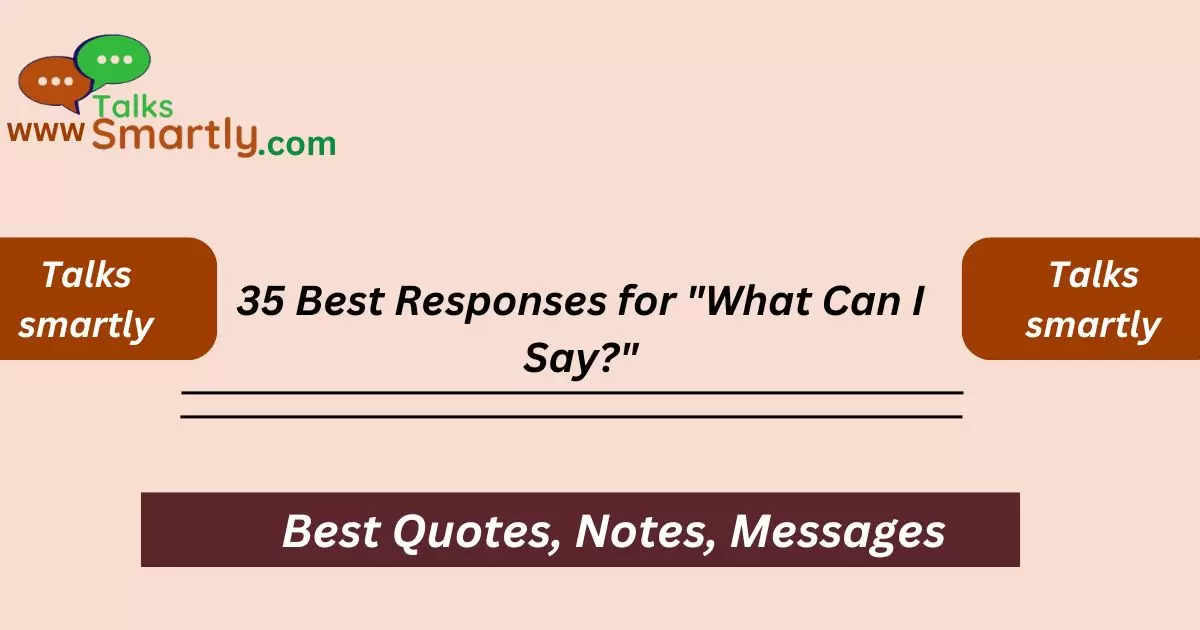“When someone asks, “What can I say?” it opens the door to countless possibilities for conversation.”
In the world of communication, knowing how to respond effectively can make a big difference. Whether in casual chats or more serious discussions, people often find themselves at a loss for words. The phrase “What can I say?” is common, and how you respond can help steer the conversation in a positive direction. This blog post explores 35 of the best responses for this question, offering a variety of options to suit different situations.
Engaging with others can be tricky, and the right words can ease tension or create a light-hearted moment. By using the responses listed here, you’ll be better prepared for your next conversation. Each response not only provides a way to keep the dialogue flowing but also helps you connect on a deeper level with the person you’re speaking to.
In this guide, you’ll find responses that range from humorous to sincere, suitable for both friends and colleagues. We’ll break down each suggestion and provide examples to help you understand how to use them effectively. Let’s dive in and discover how to respond when someone asks, “What can I say?”
Best Responses for “What Can I Say?”
- Life is unpredictable.
- Embrace the moment.
- Let’s not overthink it.
- Honesty is the best policy.
- Sometimes, silence speaks volumes.
- Share your thoughts.
- It’s all about perspective.
- Laughter is the best medicine.
- Keep it simple.
- Ask a question back.
- A compliment goes a long way.
- Offer support.
- Share a memory.
- Express curiosity.
- Use humor.
- Reflect on feelings.
- Keep it light-hearted.
- Offer a suggestion.
- Be direct.
- Share a quote.
- Offer advice.
- Take a moment to breathe.
- Acknowledge their feelings.
- Keep it honest.
- Shift the focus.
- Encourage them.
- Find common ground.
- Discuss a topic of interest.
- Use a metaphor.
- Share a fun fact.
- Encourage laughter.
- Appreciate their company.
- Show empathy.
- Be playful.
- Wrap it up with positivity.
1. Life is unpredictable.
When someone says “What can I say?” you can respond by acknowledging that life often surprises us. This shows that you understand the unpredictable nature of conversations. Example: “Life is unpredictable; sometimes, we just have to roll with the punches!”
2. Embrace the moment.
Encouraging someone to embrace the moment can lighten the mood. It suggests that enjoying the present is more important than worrying about the future.
Example: “Let’s just embrace the moment and see where this conversation takes us!”
3. Let’s not overthink it.

This response promotes a relaxed approach. It suggests that there’s no need to overanalyze the situation.
Example: “Let’s not overthink it; sometimes, a simple answer is all we need!”
4. Honesty is the best policy.
Honesty fosters trust and connection. By reminding someone of this, you encourage openness. Example: “Honesty is the best policy; just say what you feel!”
5. Sometimes, silence speaks volumes.
Acknowledging the power of silence can be profound. It suggests that words aren’t always necessary.
Example: “Sometimes, silence speaks volumes; let’s just enjoy this moment together.”
6. Share your thoughts.
Inviting the other person to share their thoughts can help facilitate conversation. It shows that you value their input.
Example: “Why don’t you share your thoughts? I’d love to hear what you think!”
7. It’s all about perspective.
This response highlights the importance of viewpoint. It encourages a broader discussion on how different perspectives shape our understanding.
Example: “It’s all about perspective; how do you see this situation?”
8. Laughter is the best medicine.
Bringing humor into the conversation can create a light atmosphere. It reminds everyone that laughter can ease tension.
Example: “Remember, laughter is the best medicine; let’s find something funny to talk about!”
9. Keep it simple.
Promoting simplicity can help eliminate confusion. This response encourages straightforwardness.
Example: “Let’s keep it simple; sometimes, less is more!”
10. Ask a question back.
Responding with a question can keep the conversation going. It shows your interest in their thoughts.
Example: “What about you? What can you say about this?”
11. A compliment goes a long way.
Offering a compliment can make someone feel appreciated and valued.
Example: “You always have great insights; what do you think?”
12. Offer support.
When someone seems unsure, offering support can be reassuring. It lets them know you’re there for them.
Example: “I’m here for you; what can I say to help?”
13. Share a memory.
Reflecting on a shared memory can strengthen bonds and add a personal touch to the conversation.
Example: “Remember that time we… That could relate to this!”
14. Express curiosity.
Showing curiosity can encourage deeper discussions. It shows you’re interested in the topic at hand.
Example: “I’m curious to know your thoughts on this!”
15. Use humor.
A funny response can lighten the mood and make the conversation more enjoyable.
Example: “Well, what can I say? I’m no magician!”
16. Reflect on feelings.
Acknowledging feelings can make conversations more meaningful. It helps create a safe space for sharing.
Example: “What can I say? It’s okay to feel a bit overwhelmed.”
17. Keep it light-hearted.
Encouraging a light-hearted approach can relieve tension. This response helps to maintain a fun atmosphere.
Example: “Let’s keep it light-hearted; we’re just chatting!”
18. Offer a suggestion.
Providing a suggestion can guide the conversation and help find solutions.
Example: “How about we talk about something else? What do you think?”
19. Be direct.
A direct response can sometimes be the best way to communicate. It cuts through uncertainty. Example: “Honestly, I think we should just address it.”
20. Share a quote.
Sharing a relevant quote can inspire or provoke thought. It adds depth to the conversation. Example: “As they say, ‘What can I say?’ Sometimes, words aren’t enough.”
Best Responses for “Happy Canada Day”
21. Offer advice.
If appropriate, giving advice can be helpful. It shows you care and want to assist.
Example: “If I were you, I’d just say what’s on your mind!”
22. Take a moment to breathe.
Encouraging a moment of calm can help when tensions are high. It reminds everyone to relax. Example: “Let’s take a moment to breathe; we can figure this out!”
23. Acknowledge their feelings.
Recognizing someone’s feelings fosters empathy. It helps validate their emotions.
Example: “What can I say? I understand this is tough for you.”
24. Keep it honest.
Stressing honesty can strengthen the conversation. It promotes transparency.
Example: “Let’s keep it honest; what do you really think?”
25. Shift the focus.
If the conversation feels stagnant, shifting the focus can bring new energy.
Example: “Let’s shift the focus; what’s something exciting you’ve experienced lately?”
26. Encourage them.
Encouraging someone can boost their confidence. It shows you believe in them.
Example: “You’ve got this! What can I say to help?”
27. Find common ground.
Discovering shared interests can deepen connections. This response encourages collaboration. Example: “What can I say? We both love talking about movies!”
28. Discuss a topic of interest.
Bringing up an interesting topic can reignite the conversation.
Example: “What can I say about art? It always fascinates me!”
29. Use a metaphor.
Metaphors can clarify complex ideas and add creativity.
Example: “Life is like a box of chocolates; what can I say?”
30. Share a fun fact.
Fun facts can spark curiosity and engagement. They make the conversation lively.
Example: “Did you know that honey never spoils? What can I say about that?”
31. Encourage laughter.
Promoting laughter can ease discomfort. This response keeps things enjoyable.
Example: “What can I say? Let’s find something to laugh about!”
32. Appreciate their company.
Expressing gratitude for someone’s company can create a warm atmosphere.
Example: “What can I say? I really enjoy chatting with you!”
33. Show empathy.

Demonstrating empathy fosters connection and understanding.
Example: “What can I say? I know how challenging this can be.”
34. Be playful.
Injecting playfulness can lighten the mood. It encourages a fun exchange.
Example: “What can I say? I’m just here for the snacks!”
35. Wrap it up with positivity.
Ending on a positive note can leave a lasting impression.
Example: “What can I say? Let’s look forward to what’s next!”
Answer the key Question
1. Why is it important to have responses ready?
Having responses ready helps maintain smooth conversations and reduces awkward silences.
2. Can humor be used in serious conversations?
Yes, humor can lighten serious topics, but it’s essential to gauge the other person’s comfort level first.
3. How can I improve my conversation skills?
Practice active listening, ask open-ended questions, and engage in diverse topics to enhance your skills.
4. What if I don’t know how to respond?
It’s okay to take your time. You can always say, “That’s a good question; let me think about it.”
5. How can I feel more confident in conversations?
Preparation helps, but so does practicing mindfulness and reminding yourself that everyone feels uncertain sometimes.
Conclusion
In conclusion, knowing how to respond when someone asks, “What can I say?” is essential for fostering engaging and meaningful conversations. The 35 responses provided in this post offer a range of options, from humorous to sincere, allowing you to connect with others in various contexts.
Remember, effective communication goes beyond just words; it involves understanding, empathy, and a genuine interest in the other person. By practicing these responses, you can navigate both light-hearted chats and more serious discussions with ease and confidence.
Ultimately, every interaction is an opportunity to build relationships and create memorable moments. So, the next time you find yourself at a loss for words, reflect on these suggestions and embrace the beauty of conversation.
Whether you choose to keep it simple or dive deep into meaningful topics, your responses will leave a lasting impact. Stay open, be authentic, and enjoy the journey of connecting with others through words.












